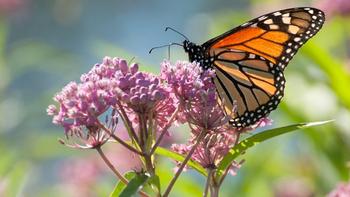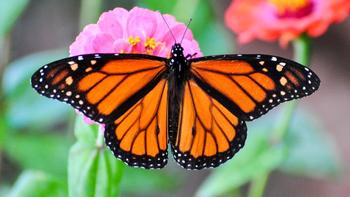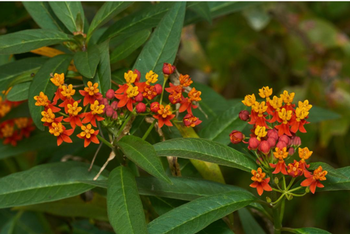Emergency! Wake up call for our beloved monarch butterflies!

Well, folks, the Western Monarch Butterfly (Danaus plexippus) is close to the extinction level. Remember the days when trees in Muir Woods would be covered in dangling orange wings as the migratory monarchs rested on their journey from California to the mountain forests in central Mexico where they hibernate from the beginning of November to mid-March? Unfortunately, those visits are less frequent now. In California, the monarch population dwindled from approximately 1.2 million in 1997 to only 2,000 in 2020.
In July 2022, the International Union for Conservation of Nature (IUCN) placed the monarchs on its Red List of Threatened Species. Conservationists, as well as the World Wildlife Fund, the Xerces Society, Monarch Joint Venture, Environmental Forum of Marin, and others, have been sounding the alarm for years. Your help is needed!
 Deforestation, climate change, pesticides, and non-native milkweed have contributed to the decline in monarch populations. Photo: Peter Miller
The monarch journey
Deforestation, climate change, pesticides, and non-native milkweed have contributed to the decline in monarch populations. Photo: Peter Miller
The monarch journey

Every fall, the butterflies travel from Canada and western states to coastal California sites on their way to Mexico, where they stay in a semi-dormant state until spring. The North American Monarch is the only known insect in the world to make the same type of annual long-distance back-and-forth migration as birds and whales.
Along their travels, they tend to gather in the same coastal places every year. Locally, they can usually be found at Fort Mason, the Marin Headlands, Fort Baker, and Muir and Stinson beaches.
In spring, increasing daylight hours and warmer weather trigger their migratory instincts to head north and east, in search of the milkweed host plant on which the females feed. They then lay their eggs, which hatch as caterpillars, turn into chrysalises, and then emerge as butterflies to continue their journey north. It may take several generations to reach their destination, and several more to return in the fall to their winter quarters as most butterflies’ lifespan is four to five weeks.
What’s causing this alarming decline in the monarch population?
- Logging and deforestation for agriculture and housing – - A dedicated wildlife corridor offering continuous habitat with water, food, and rest opportunities is necessary for the butterfly’s migration and reproduction.
- Climate change – Warmer weather and wildfires endanger the butterfly’s natural habitat. Drought challenges the growth of milkweed, their only host plant.
- Pesticides – The widespread use of pesticides including the systemic neonicotinoids makes plants toxic to pollinators. This endangers both good and bad insects.
- Tropical milkweed (Asclepias curassavica) – This milkweed species offers bright orange flowers almost year-round and is a popular landscape plant. Unfortunately, this encourages monarchs to breed year-round. Winter larvae feeding on tropical milkweed face multiple threats, including a high chance of being infected with OE parasites. In August 2022, Marin County banned the sale of tropical milkweed. If you have it growing in your garden, remove it!
- A protozoan parasite (Ophryocystis elektroscirrha or OE) is a debilitating pest that infects monarchs. Monarchs with severe OE infections can fail to emerge successfully from their pupal stage. Monarchs with mild OE infections can appear normal but live shorter lives and cannot fly was well as healthy monarchs.
What you can do to help
- Plant California native milkweed! These plants are essential to the butterfly life cycle. Monarchs need our native milkweed, Asclepias fascicularis (narrowleaf milkweed) or Asclepias speciosa (showy milkweed). If you have never grown this host plant, you will be absolutely amazed at how much these hungry caterpillars consume.
- But don’t panic if some of your caterpillars suddenly disappear. Caterpillars are necessary food for baby birds. Without caterpillars, the bird population would plummet.
- Do NOT plant non-native milkweed. This species makes monarchs more vulnerable to predators, increases their risk of OE, and possibly interrupts their migration cycle.
 Do NOT plant tropical milkweed, which is now banned in Marin nurseries. Remove this plant if it sprouts in your garden. Photo: Wikimedia Commons
Do NOT plant tropical milkweed, which is now banned in Marin nurseries. Remove this plant if it sprouts in your garden. Photo: Wikimedia Commons - Plant nectar flowers in large swaths of the same plant type.
Butterflies prefer flat-topped flowers they can land on while they feed. - Butterflies need resources other than nectar. Leave moist animal droppings or overripe fruit in the garden.
- Butterflies cannot drink from open water. Leave a pan of wet sand under a dripping faucet or place rocks in your water source so they can sip.
- Large rocks in sunny, open areas but out of the wind provide a resting place for butterflies.
- Avoid using pesticides that can harm wildlife.
- Remove invasive plants and replace them with suitable California natives.
And now for a bit of good news
The 2021 census found more than 247,000 butterflies overwintered in the state during 2021. While this is an encouraging increase, there remains a staggering loss.
Learn more about butterflies and other pollinators.

